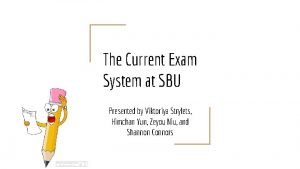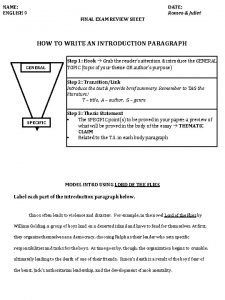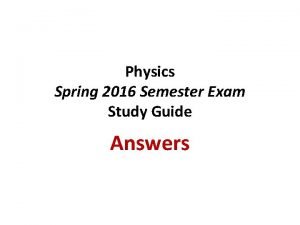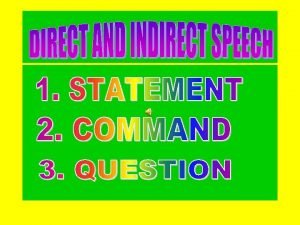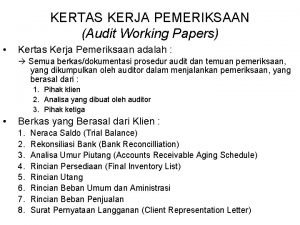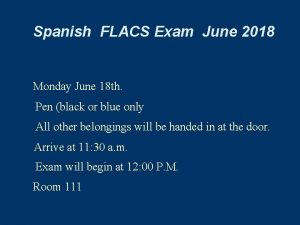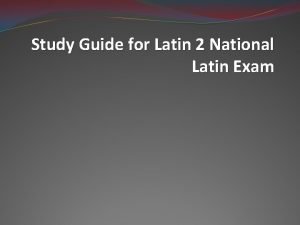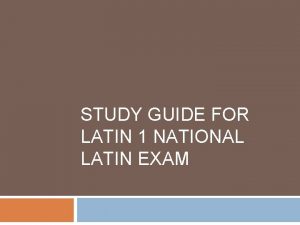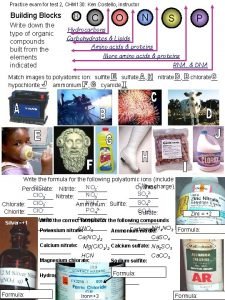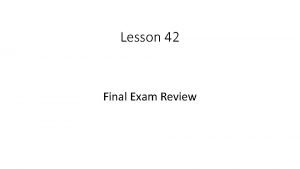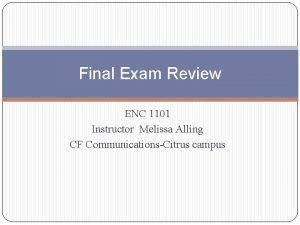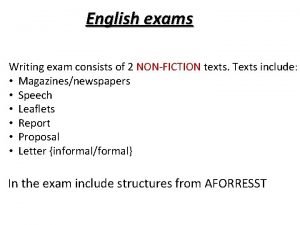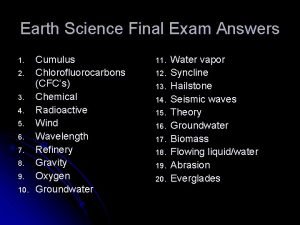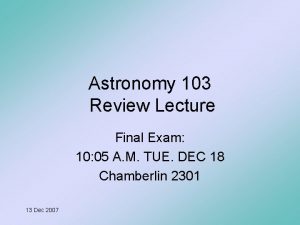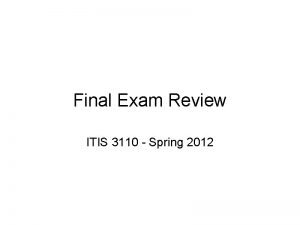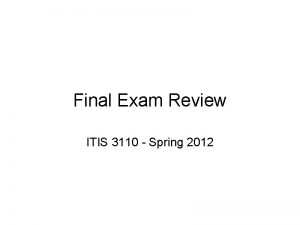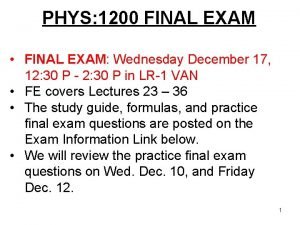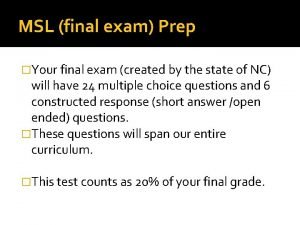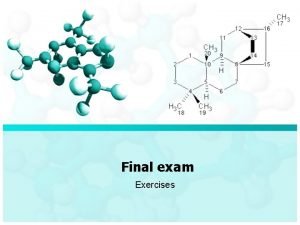Final Exam STUDY SCHEDULE SPRING 2018 Final Exam










































![Periodic Table of Elements [Go to ptable. com] Periodic Table of Elements [Go to ptable. com]](https://slidetodoc.com/presentation_image_h2/565f457d391d30d1ae0c923ed4289799/image-43.jpg)


























![C. Shorthand practice Example - Germanium [Ar] 2 4 s 10 3 d 2 C. Shorthand practice Example - Germanium [Ar] 2 4 s 10 3 d 2](https://slidetodoc.com/presentation_image_h2/565f457d391d30d1ae0c923ed4289799/image-70.jpg)


- Slides: 72

Final Exam STUDY SCHEDULE SPRING 2018

Final Exam Study Schedule Monday May 21 Tuesday May 22 Rounding Significant Figures, Scientific Notation Measurement, Accuracy, Precision Atomic Nuclear Periodic Table Electrons, Electron Configurations Periodic Table Balancing Equations

Accuracy & Precision The degree to which the result of a measurement or calculation conforms to the correct value or a standard. How close you are to the actual answer. A measurement or calculation as represented by the consistency of results. How close together your results are to one another regardless of the actual answer.

Taking Measurements When taking measurements, you always measure one digit past what you can see. This is called the “limit of precision. ”

Examples: How would you read the two graduated cylinders to the right?

REMEMBER UNITS!!! ALL NUMBERS MUST BE FOLLOWED BY A UNIT LITERS = L MILLILITERS = ML GRAMS = G NAKED NUMBERS HAVE NO MEANING IN SCIENCE! THUS WILL RECEIVE NO CREDIT!

Accuracy Precision and Error

Accuracy Precision and Error

Scientific Notation Why Scientific Notation? Scientists sometimes have to deal in very large or very small quantities, and scientific notation is a way of expressing that number. Remember the Power of 10? The Power of 10 Video

How To: Scientific Notation Rules to Follow: A positive exponent indicates that the number is greater than 1. Example: 1, 500, 000. 0 = 1. 5 x 106 A negative exponent that the number is less than 1. Standardindicates Notation Example: 0. 000025 = 2. 5 x 10 -5 Scientific Notation: Coefficient must be between 1 and 9

What Is Scientific Notation?










Scientific Notation Practice! Convert the following to scientific notation: 1. 2. 3. 4. 5. 0. 005 5 x 10 -3 5, 050 5. 05 x 103 0. 0008 8 x 10 -4 1, 000. 1. 000 x 103 1, 000 1 x 106

Do all numbers matter? Devices for measurement have a ‘limit of precision Not all numbers in a value are “significant. ” Significant figures show the accuracy and precision of a measurement How many meniscus m. L are in this graduated cylinder?

Counting Significant Figures 4 Rules to Remember: Non-zero Numbers are ALWAYS Significant Sandwiched Zeros are ALWAYS Significant Leading Zeros are NEVER Significant Trailing Zeros are SOMETIMES Significant

NON-ZERO NUMBERS Value Sig Figs 8 mm 1 42 lbs ? 678 mm ? 9 lbs ?

SANDWICHED ZEROS Value Sig Figs 50. 8 mm 3 2001 min 4 0. 702 lb ? 0. 00405 m ?

LEADING ZEROS Value Sig Figs 0. 008 mm 1 0. 0156 oz 3 0. 0042 lb ? 0. 000262 m. L ?

TRAILING ZEROS When a decimal is PRESENT: Trailing Zeros ARE Significant When a decimal is ABSENT: Trailing Zeros are NOT Signficiant Value Sig Figs 25, 000 in. 200. yr 2 3 48, 600 gal ? 25, 000. g ?

Calculations Using Sig Figs There are different rules for different mathematical operations: RULE: When multiplying and dividing the answer has the same number of significant digits as the value with the fewest. Example: 23. 0 cm x 432 cm x 19 cm = The calculated answer is 188, 784 cm 3 The reported answer is rounded to two sig figs because 19 cm has the least amount in the problem. The answer is 190, 000 cm 3

Calculations Using Sig Figs There are different rules for different mathematical operations: RULE: When adding and subtracting the answer is limited not by the significant digits, but the limit of precision! Example: 123. 25 m. L + 46. 0 m. L + 86. 257 m. L = The calculated answer is 255. 507 m. L The reported answer is rounded to the tenths place because 46. 0 m. L has the lowest limit of precision. The answer is 255. 5 m. L

Subatomic Particles The subatomic particles are distinguished by their charge, mass, and location. Particle Location Charge Mass “Job” Each has a different “job” to do with respect to its (AMU) Proton Nucleus +1 ~1 amu Determines identity of element structure. Neutro ns Nucleus 0 ~1 amu Supplies proper mass to hold nucleus together Electro ns Electron Cloud -1 ~0 amu Determines bonding and reactivity

What Is this AMU? 〉 Protons, neutrons, and electrons are all matter and part of the definition is that all matter has mass 〉 〉 normally measure using units of g or kg These numbers are so very small, that they are hard to grasp, so we came up with the Atomic Mass Unit 〉The AMU is simply a comparison unit to show that protons and neutrons have about the same mass, and that the electron is still very small in comparison.

Average Atomic Mass The average mass of all the atoms that make up this element.

Mass Number The mass number equals the total number of subatomic particles in the nucleus. #Protons + #Neutrons = Mass Number

Atomic Number The Atomic Number is found at the top of each periodic square. Each element has its own Atomic Number - atomic number: the number of protons in the nucleus of an atom. The Protons identify the atom. Change the atomic number and you have a new element!

Atomic Number and Mass Number, continued

You Try! 1. List the Atomic Number for the following elements! -B -F -K 5 9 19 2. List the Mass Numbers for the following! -Li -O -S 7 16 32

Bohr Diagrams How can we draw an atom on our paper? Start with a circle in the center – this will represent the nucleus…. What goes in the nucleus? ? Protons Draw and Neutrons! another circle around it – this will represent the first energy level for the electrons.

Bohr Diagram, cont. The 1 st energy level can only hold 2 electrons The 2 nd can hold up to 8 The 3 rd can hold a maximum of 18, but we won’t draw Bohr Diagrams for elements that big

Bohr Diagram vs. Current Atomic Theory Bohr diagrams are a vast simplification of what we now understand the atom to be! The atom actually has a bunch of different shapes of clouds within the energy levels which all overlap But more on that later…

BELL WORK How many protons, neutrons and electrons are part of each stable atom? Does the proton count resemble the electron count? Let’s Build An Atom: 1. Hydrogen 2. Oxygen 2. Carbon Standards: H. C. 2. A. 1, H. C. 2. A. 2 What happens if you add more electrons? What does the atom become? Which component (Proton, Neutron, Electron) is the single identifier of the atom? What is the number of protons called? What happens when you add too many neutrons? What do you get? What is it called?

Elements Atoms and Nuclear a. DISCOVERY OF ATOM & ATOM STRUCTURE b. PERIODIC TABLE c. ELECTRONS d. ISOTOPES AND NUCLEAR DECAY

The Periodic Table Dmitri Mendeleev & Periodic Table (CCC) Periodicity Groups (Columns) and Periods (Rows) [TED TALKS PERIODIC TABLE VIDEOS]
![Periodic Table of Elements Go to ptable com Periodic Table of Elements [Go to ptable. com]](https://slidetodoc.com/presentation_image_h2/565f457d391d30d1ae0c923ed4289799/image-43.jpg)
Periodic Table of Elements [Go to ptable. com]

An example The “s” tells you the electron’s cloud shape. In this case it’s a spherically shaped cloud. It is called the s sublevel. 1 s The “ 1” tells you how far from the nucleus the electrons are. In this case, its in the 1 st energy level, which is closest level to the nucleus. 2 The “ 2” simply tells you how many electrons are in this cloud. In this case 2 electrons are creating the cloud. Note: Each orbital can only hold 2 electrons. They must have opposite spins.

Electron Configuration

Emission vs Absorption

Why we study electrons Knowing the position of electrons helps us with many topics: Why chemical reactions occur Why some atoms are more stable than others Why some elements react with only certain atoms We want to know how many electrons an atom has, and where they’re located.

The Electron Cloud Bohr’s model of the atom only showed us that electrons have different energy levels Our current “quantum mechanical” model of the atom goes even further and talks about the different orbital shapes inside these energy levels. Quantum numbers link The world of quantum mechanics 1 2 3 4 5

4 QUANTUM NUMBERS n l m s N - Principal Energy Level Higher values of n mean more energy for the electron and the corresponding radius of the electron cloud or orbital is further away from the nucleus. Values of n start at 1 and go up by integer amounts. The higher the value of n, the closer the corresponding energy levels are to each other.

QUANTUM NUMBERS n l m s L - Angular Quantum Number In chemistry, there are names for each values of ℓ. The first value, ℓ = 0 called an s orbitals are spherical, centered on the nucleus. The second, ℓ = 1 is called a p orbitals are usually polar and form a teardrop petal shape with the point towards the nucleus. ℓ = 2 orbital is called a d orbital. These orbitals are similar to the p orbital shape, but with more 'petals' like a clover leaf. They can also have ring shapes around the base of the petals. The next orbital, ℓ=3 is called an f orbital. These orbitals tend to look similar to d orbitals, but with even more 'petals'.

QUANTUM NUMBERS n l m s M - Magnetic Quantum Number The third quantum number is the magnetic quantum number, m. These numbers were first discovered in spectroscopy when the gaseous elements were exposed to a magnetic field. This relationship shows for every value of ℓ, a corresponding set of values of m ranging from -ℓ to ℓ is found. This number determines the orbital's orientation in space. For example, p orbitals correspond to ℓ=1, can have m values of -1, 0, 1. This would represent three different orientations in space for the twin petals of the p orbital shape. They are usually defined to be px, py, pz to represent the axes they align with.

QUANTUM NUMBERS n l m s S - Spin Quantum Number The fourth quantum number is the spin quantum number, s. There are only two values for s, +½ and -½. These are also referred to as 'spin up' and 'spin down'. This number is used to explain behavior of individual electrons as if they were spinning in a clockwise or counterclockwise. The important part to orbitals is the fact that each value of m has two electrons and needed a way to distinguish them from one another. .

QUANTUM NUMBERS

QUANTUM NUMBERS SUMMARY QUANTUM Principal NUMBER Angular Momentum Magnetic Spin Symbol N l Ml Ms Values N N-1 -l to l What it describes How far the electron is f rom nucleus Describes the shape or type of orbital Describes the electron’s position in the orbital Describes the spin Values N=1, 2, 3, 4, 5, 6, 7 l=0, 1, 2, 3 s, p, d, f N-1 Ml= +1/2 counterclockwise -1/2 clockwise Maximum # e- 2 N 2 s 1 position 0 p 3 positions -1, 0, 1 D 5 positions -2, -1, 0, 1, 2 F 7 positions -3, -2, 0, 1, 2, 3 2 e for each position S=2, p=6, d=10, f=14 Maximum Pauli Exclusion Principle: N # sub Eg. e level 2 NO 2 ELECTRONS in the same atom have the same 4 quantum numbers

Orbital – region where electrons of a specific energy are likely to be. -up to 2 electrons per orbital

Summary of Principal Energy Levels, Sublevels, Orbitals Principal E Number of Types of Orbitals # Electrons Level N Sublevels =N 2 in Energy Level =2 N 2 N=1 1 1 s (1 orbital) 1 2 N=2 2 2 s (1 orbital), 2 p (3 orbitals) 4 8 N=3 3 3 s (1 orbital) 3 p (3 orbitals) 3 d(5 orbitals) 9 18 N=4 4 4 s (1 orbital) 16 4 p (3 orbitals) 4 d(5 orbitals) 4 f 25 (7 orbitals) 50 N=5 N=6 N=7 5 6 7 36 49 72 98 32

Orbital Diagrams The order in which will fill a sublevel all comes down to energy! Electrons fill the lowest energy sublevels first The periodic table helps to show this order!

C. Periodic Patterns s p 1 2 3 4 5 6 7 f (n-2) d (n-1) 6 7 © 1998 by Harcourt Brace & Company

Help a brother out…. When working out electron configuration, it’s important to understand orbital diagrams. Here are 3 rules that will help us understand interpret orbital diagrams.

A. General Rules Aufbau Principle Electrons fill the lowest energy sublevel available. You cannot skip any sublevels

A. General Rules Pauli Exclusion Principle Each orbital can hold only TWO electrons with opposite spins. Represents an electron rotating clockwise counter - clockwise

A. General Rules Hund’s Rule Within a sublevel, place one e- per orbital with the same spin before pairing them. “Empty Seat Rule” WRONG RIGHT

A Few more things…. Each arrow you draw represents an electron. (remember the three rules!) Each orbital holds 2 electrons and has different shapes The S level has only 1 orbital= total of 2 e The P level has 3 orbitals = total of 6 e The D level has 5 orbitals = total of 10 e The F level has 7 orbitals = total of 14 e

Practice Fill in the orbital diagram for Magnesium *Use your PT to help you out!

Electron Configuration An atom’s electron configuration… Describes the location of electrons within the atom Identifies the shape of the electron clouds - regions where the electrons are held. Uses numbers and letters to describe electrons’ location and which electron cloud it is part of. Essentially, summarizes the orbital diagram!

An example The “s” tells you the electron’s cloud shape. In this case it’s a spherically shaped cloud. It is called the s sublevel. Sublevel = Shape 1 s The “ 1” tells you how far from the nucleus the electrons can go. In this case, its in the 1 st energy level, which is the closest level to the nucleus. 2 The “ 2” simply tells you how many electrons are in this cloud. In this case 2 electrons are creating the cloud. Note: Every orbital can only hold 2 electrons. They must have opposite spins.

B. Notation Orbital Diagram O 8 e- 1 s 2 s z. Electron Configuration 2 2 4 1 s 2 s 2 p 2 p

C. Periodic Patterns Shorthand Configuration This is a shorter way to do e- configurations Steps… 1) Write the symbol of the element your doing 2) Find the noble gas (group 18) that comes before the element you are doing. 3) To begin, put that noble gas in [brackets] 4) Starting with that noble gas, finish the configuration electron

B. Notation Longhand Configuration S 16 e 6 2 2 2 1 s 2 s 2 p 3 s Core Electrons Valence Electrons z. Shorthand Configuration S 16 e 4 3 p 2 4 [Ne] 3 s 3 p
![C Shorthand practice Example Germanium Ar 2 4 s 10 3 d 2 C. Shorthand practice Example - Germanium [Ar] 2 4 s 10 3 d 2](https://slidetodoc.com/presentation_image_h2/565f457d391d30d1ae0c923ed4289799/image-70.jpg)
C. Shorthand practice Example - Germanium [Ar] 2 4 s 10 3 d 2 4 p

Practice these in shorthand Li N Mg C

Draw this! This will help It is a way to remember the order in which electrons fill their orbitals. When you reach the far Left side, you reach a “wall” and must go back to The right hand side.
 World history spring final exam review answers
World history spring final exam review answers Sbu finals schedule
Sbu finals schedule California coast university challenge exam answers
California coast university challenge exam answers Drc uic
Drc uic World history and geography final exam study guide
World history and geography final exam study guide American history final exam
American history final exam Physical science jeopardy
Physical science jeopardy Romeo and juliet final exam study guide
Romeo and juliet final exam study guide Environmental science final
Environmental science final Civics and economics final exam
Civics and economics final exam Ap world history final exam
Ap world history final exam Physics semester 1 final exam study guide answers
Physics semester 1 final exam study guide answers World history 1st semester final review answers
World history 1st semester final review answers Zoology final exam study guide
Zoology final exam study guide Pols 1101 final exam
Pols 1101 final exam World history semester 1 final exam study guide answers
World history semester 1 final exam study guide answers Father said to me don't stay
Father said to me don't stay Four seasons korean movie
Four seasons korean movie Months that are in spring
Months that are in spring Dada la siguiente secuencia rusia 2018 rusia 2018
Dada la siguiente secuencia rusia 2018 rusia 2018 Kertas kerja prosedur pemeriksaan
Kertas kerja prosedur pemeriksaan Com(2018) 375 final
Com(2018) 375 final 12 principles of master production scheduling
12 principles of master production scheduling Flacs checkpoint b spanish exam june 2018 answers
Flacs checkpoint b spanish exam june 2018 answers Flacs checkpoint b spanish exam june 2017 answers
Flacs checkpoint b spanish exam june 2017 answers Ny state ela test 2019
Ny state ela test 2019 2017 viscom exam
2017 viscom exam Hospitality hsc
Hospitality hsc George pook
George pook Louisiana state board esthetician practical exam
Louisiana state board esthetician practical exam Study schedule
Study schedule Study schedule
Study schedule Web design final exam
Web design final exam Latin 2 final exam
Latin 2 final exam Sid space latin
Sid space latin Street law final exam
Street law final exam Spanish 2 final exam 100 questions
Spanish 2 final exam 100 questions Spanish final exam review packet answer key
Spanish final exam review packet answer key English 3 semester exam
English 3 semester exam Biology second semester final exam answers
Biology second semester final exam answers Human body systems final exam
Human body systems final exam Realidades 2 final exam
Realidades 2 final exam Chm 151 final exam
Chm 151 final exam Chm 130 chapter 12 practice problems answer key
Chm 130 chapter 12 practice problems answer key Truss practice problems poe
Truss practice problems poe Mat1033 final exam
Mat1033 final exam 42 final exam
42 final exam I am not contraction
I am not contraction Ied final exam
Ied final exam Hrm final exam
Hrm final exam Hospitality and tourism final exam
Hospitality and tourism final exam Hbs final exam practice test
Hbs final exam practice test Us history semester exam review answers
Us history semester exam review answers Animal science final exam
Animal science final exam Principles of business final exam answer key
Principles of business final exam answer key Enc 1101 final exam
Enc 1101 final exam Spanish 2 review packet answers
Spanish 2 review packet answers Safeschools training answers
Safeschools training answers Creative nonfiction final exam
Creative nonfiction final exam Her husbands wallet was full of curious items
Her husbands wallet was full of curious items World literature exam
World literature exam Earth science semester 2 final exam answers
Earth science semester 2 final exam answers Cs 1104
Cs 1104 Cs 1101 programming fundamentals final exam
Cs 1101 programming fundamentals final exam Gold coast final exam
Gold coast final exam Astronomy 103 final exam
Astronomy 103 final exam Ap gov final review
Ap gov final review American literature final exam
American literature final exam U.s. history semester 2 final exam
U.s. history semester 2 final exam Final exam review algebra 1
Final exam review algebra 1 Geometry final review
Geometry final review Used font
Used font ____________is used to give the tab space in vb.net
____________is used to give the tab space in vb.net

